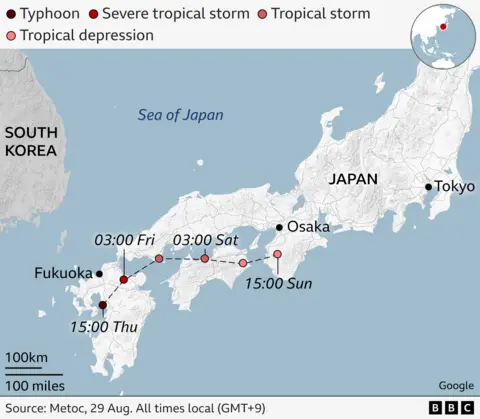More than five million people in Japan have been told to evacuate their homes after the country was hit by one of its strongest typhoons in decades.
At least four people have been killed and more than 80 injured after Typhoon Shanshan made landfall in the country’s south-west.
Hundreds of thousands of people have been left without power.
The typhoon has now weakened to a severe tropical storm and is making its way north-east, bringing torrential rain and severe disruption to transport services.
Most of the evacuation orders are in place for the southern island of Kyushu, but some are also in place for central Japan.
Late on Tuesday, three people from the same family – a couple in their 70s and a man in his 30s – were killed by a landslide in central Japan ahead of the typhoon’s arrival.
Their home in Gamagori was swept away, while two other female relatives were rescued.
A fourth person was confirmed dead by police on Thursday.
The 80-year-old man from Tokushima prefecture was trapped after the roof of a house collapsed about 17:30 local time (08:30 GMT), according to Japan’s national broadcaster NHK.
The fire brigade rescued the man around 50 minutes after the incident but he later died in hospital.
The Japan Meteorological Agency (JMA) recorded 110mm of rainfall in the area around the time of the incident.
Shanshan landed in Kagoshima prefecture, in the southern island of Kyushu, at around 08:00 local time (23:00 GMT), the Japan Meteorological Agency (JMA) said.
The agency has issued its rare “special warning” for the most violent storms, warning of landslides, flooding and large-scale damage.
High winds of up to 252 km/h (157mph) have been reported on the island.
Videos online show large trees swaying, tiles blown off houses, and debris being thrown into the air as heavy rains lashed the island.
Major carmakers like Toyota and Nissan shut down their plants, citing the safety of employees as well as potential parts shortages caused by the storm.
Map shows predicted path of Shanshan

Hundreds of flights to and from southern Japan have been cancelled, with some high-speed train services have also been suspended.
JMA expects the storm to move across Japan over the weekend before it reaches the capital Tokyo.
Special typhoon warnings, like the one issued for Shanshan, are declared in Japan in cases of extraordinarily powerful storms.
The same warning was issued in September 2022 as Typhoon Nanmadol approached Kyushu – the first such warning declared for a region other than Okinawa.
Shanshan comes in the wake of Typhoon Ampil earlier this month, which caused only minor injuries and damage but still disrupted hundreds of flights and trains.
Before that, northern parts of Japan saw record rainfall when Tropical Storm Maria hit Honshu island.
Typhoons in the region have been forming closer to coastlines, intensifying more rapidly and lasting longer over land due to climate change, according to a study released last month.
Additional reporting by Chika Nakayama in Tokyo


